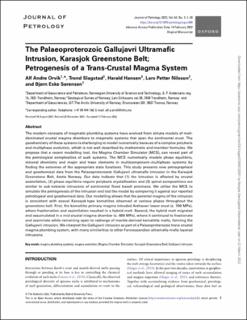| dc.contributor.author | Orvik, Alf Andre | |
| dc.contributor.author | Slagstad, Trond | |
| dc.contributor.author | Hansen, Harald | |
| dc.contributor.author | Nilsson, Lars Petter | |
| dc.contributor.author | Sørensen, Bjørn Eske | |
| dc.date.accessioned | 2022-03-28T14:21:02Z | |
| dc.date.available | 2022-03-28T14:21:02Z | |
| dc.date.created | 2022-03-23T13:22:43Z | |
| dc.date.issued | 2022 | |
| dc.identifier.citation | Journal of Petrology. 2022, 63 (3), 1-28. | en_US |
| dc.identifier.issn | 0022-3530 | |
| dc.identifier.uri | https://hdl.handle.net/11250/2988115 | |
| dc.description.abstract | The modern concepts of magmatic plumbing systems have evolved from simple models of melt-dominated crustal magma chambers to magmatic systems that span the continental crust. The geochemistry of these systems is challenging to model numerically because of a complex polybaric and multiphase evolution, which is not well described by mathematic end-member formulas. We propose that a recent modelling tool, the Magma Chamber Simulator (MCS), can reveal part of the petrological complexities of such systems. The MCS numerically models phase equilibria, mineral chemistry and major and trace elements in multicomponent–multiphase systems by finding the extremes of the appropriate state functions. This study presents new petrographical and geochemical data from the Palaeoproterozoic Gallujavri ultramafic intrusion in the Karasjok Greenstone Belt, Arctic Norway. Our data indicate that (1) the intrusion is affected by crustal assimilation, (2) phase equilibria require polybaric crystallisation and (3) spinel compositions are similar to sub-volcanic intrusions of continental flood basalt provinces. We utilise the MCS to simulate the petrogenesis of the intrusion and test the model by comparing it against our reported petrological and geochemical data. Our modelling shows that the parental magma of the intrusion is consistent with coeval Karasjok-type komatiites observed at various places throughout the greenstone belt. First, the komatiitic primary magma intruded Archaean lower crust (c. 700 MPa), where fractionation and assimilation resulted in a hybrid melt. Second, the hybrid melt migrated and accumulated in a mid-crustal magma chamber (c. 400 MPa), where it continued to fractionate and assimilate while remaining open to recharge of mantle-derived komatiitic melts, forming the Gallujavri intrusion. We interpret the Gallujavri intrusion as part of a Palaeoproterozoic trans-crustal magma plumbing system, with many similarities to other Fennoscandian ultramafic-mafic layered intrusions. | en_US |
| dc.language.iso | eng | en_US |
| dc.publisher | Oxford University Press | en_US |
| dc.rights | Navngivelse 4.0 Internasjonal | * |
| dc.rights.uri | http://creativecommons.org/licenses/by/4.0/deed.no | * |
| dc.title | The Palaeoproterozoic Gallujavri Ultramafic Intrusion, Karasjok Greenstone Belt; Petrogenesis of a Trans-Crustal Magma System | en_US |
| dc.type | Peer reviewed | en_US |
| dc.type | Journal article | en_US |
| dc.description.version | publishedVersion | en_US |
| dc.source.pagenumber | 1-28 | en_US |
| dc.source.volume | 63 | en_US |
| dc.source.journal | Journal of Petrology | en_US |
| dc.source.issue | 3 | en_US |
| dc.identifier.doi | https://doi.org/10.1093/petrology/egac008 | |
| dc.identifier.cristin | 2011985 | |
| dc.relation.project | Norges forskningsråd: 269842 | en_US |
| dc.relation.project | Norges teknisk-naturvitenskapelige universitet: 81771445 | en_US |
| cristin.ispublished | true | |
| cristin.fulltext | original | |
| cristin.qualitycode | 2 | |

